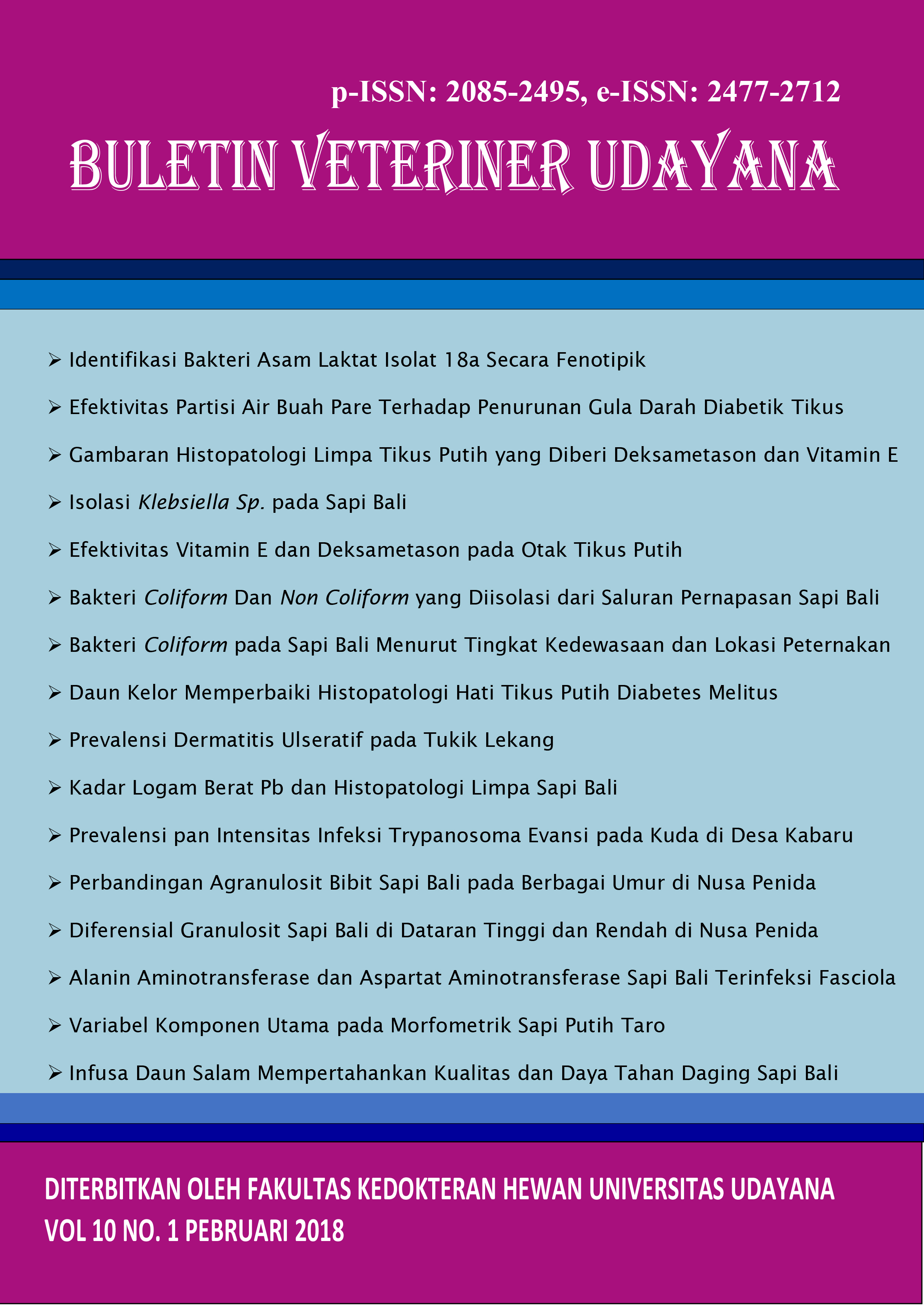PREVALENCE AND INTENSITY OF TRYPANOSOMA EVANSI INFECTION IN HORSE at THE KABARU VILLAGE, SUBDISTRICT RINDI, EAST SUMBA REGENCY
Abstract
Surra is a parasitic disease caused by Trypanosoma evansi. The incidence of trypanosomiasis was influenced by geographical conditions, management system, vector, and host. The aim of this research is to determine the prevalence and intensity of T. evansi infection in horse in Kabaru village, subdistrict Rindi. The sample used was blood from 100 horses taken from Kabaru Village. Blood collected was done through a jugular vein and a thin blood smear were made then stained with Giemsa 10%. Preparations of blood smear were examined under microscope to determine the T. evansi infection and intensity were calculated on average number of T. evansi in 100 red blood cells. The result showed that 8% of blood sample infected by T. evansi with the infection intensity of 13-71 parasites with an average number of 34.5 ± 22.7. The prevalence of sex-based infections was found in males at 12% and females at 6.7%. There was no significant difference in prevalence of T. evansiinfection between male and female horse.
Downloads
References
Bhutto B, Gadahi JA,Shah G, Dewani P and Arijo AG. 2010. Field Investigation on the Prevalence of Trypanosomiasis in Camels in Relation to Sex, Age, Breed and Herd Size. Pak. Vet. J. 30(3): 175-177.
Coen PG, Luckins AG, Davison HC, and Woolhouse MEJ. 2001. Trypanosoma evansi in Indonesian buffaloes: evaluation of simple models of natural immunity to infection. Epidemiol. Infect. 126: 111-122.
Dadi-Mamud NJ, Kabir MA, Dibal DM, Rajab MH. 2012. Study on Prevalenceof Haemoparasites of Pigeon (Columbia livia) in Lapai-Nigeria. IJABR. 4(1&2): 121–127.
Desquesnes M. 2004.Livestock Trypanosomoses and their Vectors in Latin America. Centre de coopération internationaleen recherche agronomique pour le développement (CIRAD)/Élevage et médecine vétérinaire tropicale (EMVT). ISBN: 92-9044-634-X.
Desquesnes M, Philippe H, De-Hua L, Alan D, Zhao-Rong L, and Sathaporn J. 2013. Trypanosoma evansi and Surra: A Review and Perspectives on Origin, History, Distribution, Taxonomy, Morphology, Hosts, and Pathogenic Effects. Bio. Med. Res. Int. 2013:22.
Eyob E, and Matios L. 2013. Review on camel trypanosomosis (surra) due to Trypanosoma evansi: Epidemiology and host response. J. Vet. Med. Anim. Health. 5(12): 334-343.
Herczeg T, Dénes S, Miklós B, András B, Mónika G, Róbert F and Gábor H. 2015. The effect of weather variables on the flight activity of horseflies (Diptera: Tabanidae) in the continental climate of Hungary. Parasitol. Res. 114: 1087–1097.
Herrera HM, Da´vilab AMR, Noreka A, Abreuc UG, Souzab SS, D’Andread PS, Jansena AM. 2004. Enzootiology of Trypanosoma evansi in Pantanal, Brazil. Vet. Parasitol. 125: 263–275.
Tehsheen S, Jahan N, Desquesnes M, Shahzad MI, Qamar MF. 2016. Field investigation of Trypanosoma evansi and comparative analysis of diagnostic tests in horses from Bahawalpur, Pakistan. Turk. J. Vet. Anim. Sci. 41: 288-293.
Kassa T, Tadesse E and Hassen. 2011. Prevalence of camel Trypanosomosis and its vectors in Fentale district, South East Shoa Zone, Ethiopia. Vet. Arhc. 81: 611-621.
Laha R, and Sasmal NK. 2008. Endemic status of Trypanosoma evansi infection in a horse stable of eastern region of India – a field investigation. Trop. Anim. Health Prod. 40(5): 357–361.
Lehane MJ. 2005. The Biology of Blood-Sucking in Insects. Cambridge University Press.
Mastra IK. 2011. Seroprevalensi Trypanosomiasis di Pulau Sumbawa, Nusa Tenggara Barat. Bul. Vet. 23(79).
Metanawey-El, NadiaTM, El-Beih M, Abdel El-Aziz., Hassanane, MS and Abd El- Aziz TH. 2009. Comparative Studies on Diagnosis of Trypanosoma evansiin Experimentally Infected Goats. Global Vet. 3(4): 348-353.
Muieed MA, Chaudhary ZI, Shakoori AR. 2010. Comparative studies on the sensitivity of polymerase chain reaction (PCR) and microscopic examination for the detection of Trypanosoma evansi in horses. Turk. J. Vet. Anim. Sci. 34(6): 507-512.
Nadeem A, Asim A, Zafar IC, Kamran A, Khalid S, Nisar A, Ishtiaq A and Habib UR. 2010. Indirect fluorescent antibody technique based prevalence of Surra in equines. Pak. Vet. J. 31(2): 169-170.
Radita Besse Dewisari Nur. 2017. Deteksi Trypanosoma evansi pada Kuda (Equss caballus) di Kabupaten Wajo. Skripsi, Fakultas Kedokteran Hewan universitas Hasanuddin.
Reid SA. 2002. Trypanosoma evansi control and containment in Australasia. Trends. Parasitol. 18(5): 219-224.
Silva JAD, DomicianoI TO, MontãoI DP, Sousa PGS, Ramos LL, Paredes LJA, MonteiroI SG, Rivero GRC, Júnior ASPB, Duarte Cerqueira IABVD. 2016. Reemerging of natural infection by Trypanosoma evansi in horses in Arari, Marajó Island, Brazil. Ciência Rural, Santa Maria. ISSN 1678-4596.





